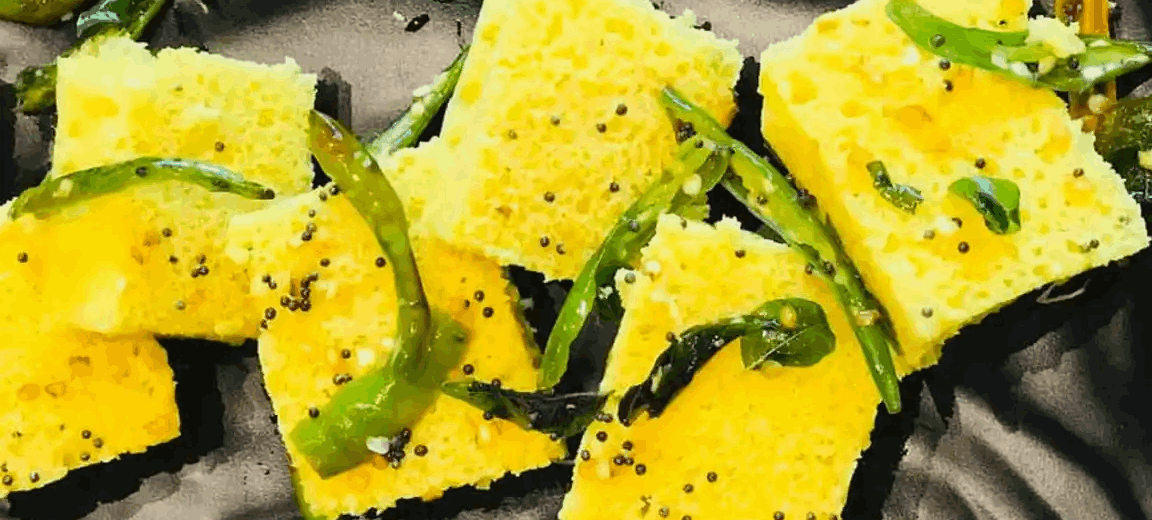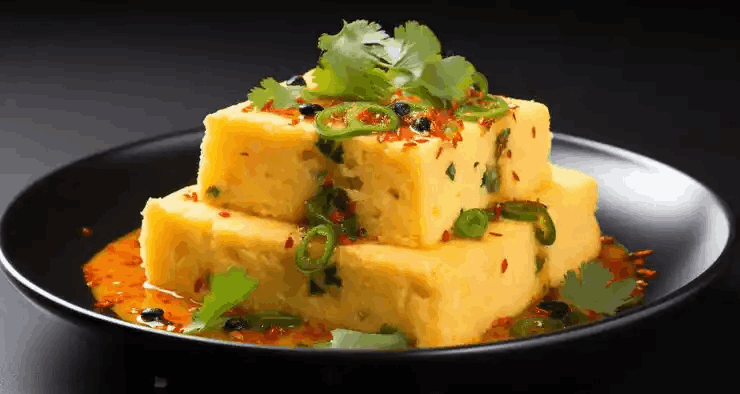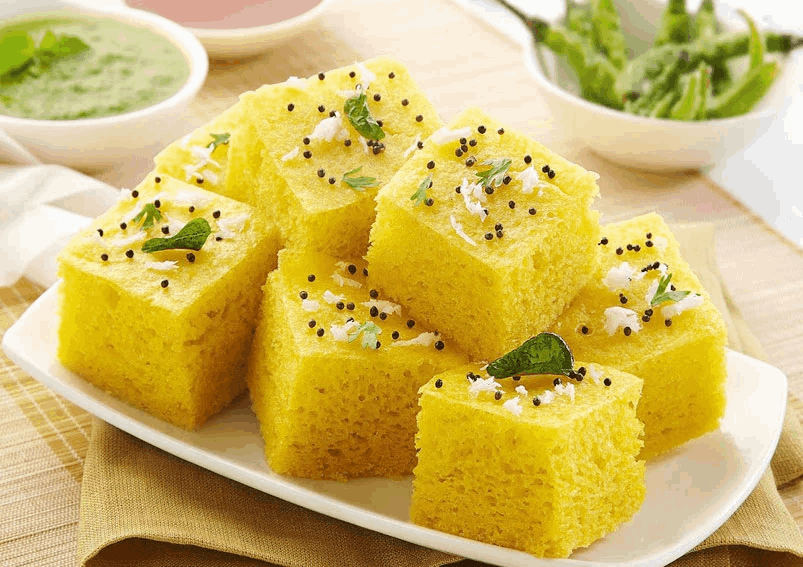Dhokla, a beloved dish from the Indian state of Gujarat, is a testament to the rich and diverse culinary heritage of South Indian cuisine. Often mistaken for a South Indian dish due to its popularity across India, dhokla is actually rooted in Gujarat. However, its appeal has transcended regional boundaries, earning it a place in the hearts (and stomachs) of food lovers everywhere. This article delves into the multifaceted world of dhokla, exploring its history, ingredients, preparation, variations, nutritional benefits, and cultural significance.
The Origins and Evolution of Dhokla
Historical Background
Dhokla has been a staple in Gujarati cuisine for centuries, with its origins tracing back to the ancient Indian practice of fermenting grains and pulses. Traditional dhokla, known as “khaman dhokla,” is a savory steamed cake made from fermented gram flour (besan) and spices. The process of making dhokla involves a combination of soaking, grinding, fermenting, and steaming, techniques that have been refined over generations.
Cultural Significance
In Gujarat, that is not just a popular snack but a symbol of hospitality and festive celebration. It is commonly served at breakfast, as a snack, or as part of a larger meal. Its light, fluffy texture and mildly tangy flavor make it a favorite among both children and adults. Dhokla’s role in festive occasions and its presence in daily meals highlight its importance in the culinary culture of Gujarat.
Ingredients and Preparation of Dhokla
Basic Ingredients
The primary ingredients for making traditional dhokla include:
- Besan (Gram Flour): The main ingredient, besan, is made from ground chickpeas. It forms the base of the dhokla batter.
- Yogurt: Yogurt is used to add a tangy flavor and to aid in fermentation.
- Eno Fruit Salt or Baking Soda: These are leavening agents that help the batter rise and become fluffy.
- Spices: Common spices include turmeric powder, mustard seeds, and curry leaves.
- Sugar: A small amount of sugar balances the savory and tangy flavors.
Preparation Process
- Mixing the Batter: The batter is made by mixing besan, yogurt, water, spices, and sugar. It is important to achieve a smooth, lump-free consistency.
- Fermentation: Some recipes call for a short fermentation period, while others use immediate preparation. Fermentation enhances the flavor and texture of dhokla.
- Steaming: The batter is poured into a greased steaming tray and steamed for approximately 15-20 minutes. The steam helps the batter rise and cook evenly.
- Tempering: After steaming, dhokla is tempered with mustard seeds, curry leaves, and green chilies to add extra flavor.
Detailed Preparation Steps
1. Prepare the Batter:
- In a mixing bowl, combine besan, yogurt, water, turmeric powder, salt, and sugar. Whisk until smooth.
- If desired, add a pinch of baking soda or Eno fruit salt to the batter to aid in rising.
2. Fermentation (Optional):
- Let the batter sit in a warm place for about 30 minutes to an hour. This step is optional but helps develop a slightly tangier flavor.
3. Steaming:
- Grease the steaming tray or pan. Pour the batter into the tray, spreading it evenly.
- Place the tray in a preheated steamer or a large pot with a lid. Steam for 15-20 minutes, or until a toothpick inserted into the center comes out clean.
4. Tempering:
- Heat oil in a small pan. Add mustard seeds and let them splutter.
- Add curry leaves and sliced green chilies. Stir for a few seconds.
- Pour this tempering over the steamed dhokla.
5. Garnishing and Serving:
- Garnish with fresh coriander leaves and grated coconut if desired.
- Cut into squares and serve hot or at room temperature with chutneys or pickles.

Variations of Dhokla
Dhokla is a versatile dish with numerous regional and ingredient-based variations. Here are some popular types:
Khaman Dhokla
Khaman dhokla is the most common type and is known for its soft, spongy texture. It is made with besan and fermented with yogurt, giving it a slightly tangy taste.
Khandvi
Khandvi is a variation made from a similar batter but cooked on a stovetop until it thickens. The mixture is then spread thinly, rolled up, and cut into bite-sized pieces. It is often garnished with sesame seeds and coconut.
Dhokla Sandwich
This innovative version layers dhokla slices with chutneys and fillings, creating a sandwich-like snack that combines the traditional flavors with a modern twist.
Rawa Dhokla
Rawa dhokla is made with semolina (rawa) instead of besan. It has a slightly different texture and flavor, often including ingredients like yogurt and ginger.
Methi Dhokla
Methi dhokla incorporates fenugreek leaves (methi) into the batter, adding a distinctive herbal flavor. It is a nutritious variation that highlights the versatility of dhokla.
Moong Dal Dhokla
Made with split yellow moong dal instead of besan, this version is lighter and has a different texture and flavor profile. It often includes vegetables and spices for added taste.
Traditional Accompaniments
It is typically enjoyed with various accompaniments that complement its flavor and texture. Here are some popular choices:
Chutneys
- Coriander Chutney: A refreshing chutney made with fresh coriander leaves, green chilies, and lemon juice.
- Tamarind Chutney: A sweet and tangy chutney made from tamarind, sugar, and spices.
- Mint Chutney: Made from mint leaves, yogurt, and spices, this chutney adds a cool and zesty flavor to dhokla.
Pickles
- Mango Pickle: A spicy and tangy pickle made from raw mangoes and a blend of spices.
- Lemon Pickle: Made from lemons and seasoned with mustard seeds and spices, this pickle adds a burst of flavor.
Yogurt
A dollop of plain yogurt can add a creamy, tangy contrast to the spongy texture of dhokla. It also helps balance the flavors.
Nutritional Benefits
Dhokla offers several nutritional benefits, making it a healthy choice for those seeking a light and nutritious snack or meal option.
Rich in Protein
Besan, the primary ingredient in dhokla, is a good source of plant-based protein. Protein is essential for muscle growth, repair, and overall body function.
Low in Fat
It is steamed rather than fried, which reduces its fat content compared to many other snack options. This makes it a healthier choice for those monitoring their fat intake.
High in Fiber
The use of besan and other ingredients like fenugreek leaves (in methi dhokla) provides dietary fiber, which aids in digestion and helps maintain a healthy digestive system.
Vitamin and Mineral Content
Dhokla contains various vitamins and minerals, including iron, calcium, and B vitamins, depending on the specific ingredients used. These nutrients contribute to overall health and well-being.
Gluten-Free Option
Since dhokla is typically made with besan, it is naturally gluten-free, making it suitable for individuals with celiac disease or gluten sensitivity.

Global Cuisine
Popularity in India
In India, it is a staple at breakfast tables, snack time, and festive occasions. Its light, fluffy texture and mild flavor make it a versatile dish that can be enjoyed with a variety of accompaniments.
International Adaptations
As Indian cuisine has gained global recognition, it has also found its way onto international menus. It is often featured in Indian restaurants around the world and has been adapted to suit local tastes and preferences.
Fusion Dishes
Innovative chefs have created fusion dishes that incorporate dhokla into different cuisines. Examples include dhokla wraps, where it is used as a base for wraps filled with various ingredients, and dhokla burgers, where dhokla patties are used in place of traditional burger buns.
The Art of Perfecting
Common Mistakes and How to Avoid Them
Creating the perfect dhokla involves attention to detail. Here are some common mistakes and tips to avoid them:
- Batter Consistency: The batter should be smooth and lump-free. If it is too thick, the dhokla may not rise properly. If too thin, it may become dense.
- Steaming Time: Oversteaming or understeaming can affect the texture of that food . Check for doneness by inserting a toothpick; it should come out clean.
- Temperature Control: Ensure the steaming environment is adequately heated before placing the batter. A preheated steamer helps in achieving an even rise.
Expert Tips
- Use Fresh Ingredients: Fresh besan and yogurt yield the best results. Avoid using stale or expired ingredients.
- Proper Greasing: Grease the steaming tray well to prevent the dhokla from sticking. This makes it easier to remove and cut into pieces.
- Allow for Cooling: Let the dhokla cool for a few minutes after steaming before cutting. This helps in achieving clean cuts and prevents crumbling.

Cultural and Social Significance
Festivals and Celebrations
In Gujarat, it is often prepared for festivals such as Diwali and Navratri. Its light and fluffy texture makes it an ideal food for celebratory feasts. It is also a common offering in religious ceremonies and community gatherings.
Dhokla as a Social Dish
this is frequently served at social events and gatherings, reflecting its role as a communal dish. It brings people together, fostering a sense of community and sharing.
Stories and Anecdotes
Many families have their own special recipes and traditions related to dhokla. Stories of family gatherings, festive celebrations, and culinary adventures involving dhokla highlight its significance in Indian culture.
Conclusion
It is more than just a snack; it is a culinary icon that represents the rich heritage and diverse flavors of Indian cuisine. From its ancient origins in Gujarat to its global popularity, its continues to captivate food lovers with its unique texture, flavor, and versatility. Whether enjoyed as a traditional dish or a modern fusion creation, dhokla remains a beloved part of the culinary landscape, embodying the spirit of innovation and tradition.
As you explore the world of dhokla, whether by preparing it at home or enjoying it at a restaurant, you are participating in a culinary tradition that has been cherished for centuries. Embrace the flavors, appreciate the history, and savor the delightful experience of dhokla—an enduring symbol of gastronomic excellence.
